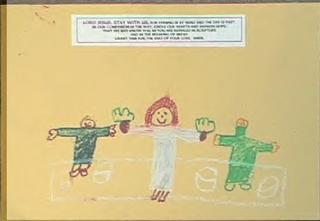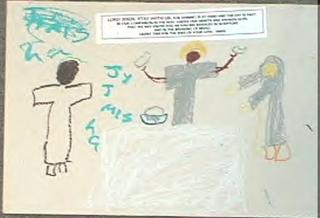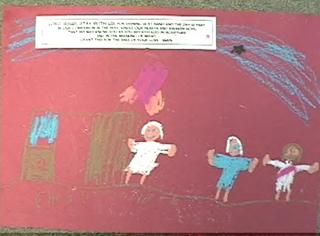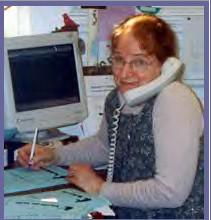ARTICLE ON LIGHT AND PEACE IN SEWANEE THEOLOGICAL REVIEW
I'm delighted to announce that my article on Light and Peace is appearing in the Michaelmas 2005 edition of Sewanee Theological Review (Volume 48:4). The article is entitled "Light and Peace: Liturgical Evangelism with Urban Children," and describes the adapted form of Compline, followed by an art project and supper, that we have offered for over ten years now at the Children's Mission of St. Paul and St. James. Our version of Compline includes scripture storytelling using the feltboard story pieces that I developed, which are now on the market as Beulah Land.
The article describes the program and some of its theological rationale, particularly the importance of consistent liturgical structure for children whose lives often lack stability and ritual. It then goes on to explore the role of the feltboard in freeing children to explore scripture through art:
This kind of play with the “language system of the Christian faith” is a natural outgrowth of the use of manipulables in storytelling, as anyone can testify who has worked with any of the Montessori-based religious education systems. A distinctive feature of the Beulah Land© feltboard pieces, however, is that they are constructed entirely from two-dimensional shapes, in brightly contrasting colors, and are combined and recombined into flat, easily legible visual compositions, which can come to serve as models for the children’s own efforts to translate their emotional and spiritual investment in the story into art. …
Children draw hearts and crosses in church because these are the Christian images that are universally accessible in our culture and are so simple, so visually standardized, as to be available to any child. They also draw manger scenes—another rich and powerful Christian image, and the only fairly complex scriptural scene that is reproduced often enough, and consistently enough, that children who do not feel they know how to draw will nonetheless go to work to portray it. But beyond these few images, our children are mute—lacking in vocabulary and grammar—as they seek to explore spiritual questions, concerns and feelings through drawing. …
The feltboard stories used at Light and Peace can open up a whole new world for children all along the demographic spectrum. Unlike most Sunday school curriculums, they provide, week by week, a consistent stock of simple, stylized (but emotionally rich) visual images for the crucial elements of scriptural and liturgical language—water, fire, garden, desert, mountain, city, river, stars, ark, shepherd, sheep, temple, and so many more—that convey the psychic and spiritual power of our story.
Children can see and experience how the combination of simple shapes creates a complex scene, and this discovery invites them to experiment not only with manipulating the pieces for themselves, but also with creating original art work incorporating the same elements. They move from asking, What if this piece were placed here? through Where do I want to put this piece? ... and then on to What could I put here? The process is radically empowering.
New energy and confidence appear in Sunday school projects such as banner making and decorative crafts. And as the children assimilate and appropriate the shapes over time, they do not simply mechanically reproduce them. Their own art work becomes freer and more confident. Coming to their art table from worship and story, even though the feltboard has been left behind in the chapel, they go right to work. They are comfortable with the stories and with the symbols representing the stories. They see themselves as having mastery of the symbols—as capable of deciding how to arrange them and what to include.
The article was meant to be accompanied by a series of illustrations--first of the feltboard tableau illustrating the story of the Road to Emmaus (Luke 24:30-35), and then of the spontaneous artwork of a small group of seven- and eight-year olds:
On each table are large sheets of construction paper, oil pastels, and slips of paper on which has been printed out the closing prayer used all year long:
"Lord Jesus, stay with us, for evening is at hand and the day is past. Be our companion in the way, kindle our hearts and awaken hope, that we may know you as you are revealed in scripture and in the breaking of bread. Grant this for the sake of your love. Amen."
At one table, eight second- and third-graders are gathered. They laboriously read the prayer, and paste it to their paper—top, bottom, wherever they please. Some of them catch the connection with this week’s story. Then they set to work. Most of them begin by drawing, somewhere in the top half of the page, a red heart with two brown hands reaching down. Each of them draws the risen Christ, with one or more disciples. His hands are outstretched, and wounded. But all their drawings are different. In one, he stands at the center, behind the table, flanked by the disciples and lifting the broken bread. A little girl draws him standing beside Mary Magdalene in a garden. Their work has spontaneity and emotional power. Nobody copies off of each other. Nobody says “I can’t draw.” They are busy, absorbed, cooperating, sharing the crayons, enjoying the process and the sense of achievement, talking about their feelings, appreciating each other’s work.
Unfortunately, due to a technical problem, the children's artwork was omitted from the magazine, and the photograph of the feltboard appeared only in black and white. So I'm taking the opportunity of using this blog as a way to access the illustrations for the article. The resolution is not top-quality (that was the technical problem), but it's quite possible to get the general idea of what the children were doing with the materials at hand. [A note: the strip of paper that each child has glued to his or her drawing contains the full text of the evening prayer, "Lord Jesus, stay with us".]








Labels: Beulah Land, children's art, publications, Sunday School, urban ministry, worship


1 Comments:
Gretchen, thanks for your writing on this children's project. It looks a little like the 'godly play' we use in our Sunday School over here in England at Ely Cathedral.
I wanted to be in touch because I have written an article that I think might be appropirate for the Sewanee Theological Review and wondered if you have an email contact for that journal. would be grateful to hear from you.
denise_inge@yahoo.co.uk. I'm a lay person, theological writer, mother of two girls. Thanks.
Post a Comment
<< Home